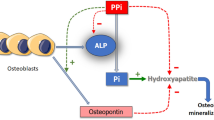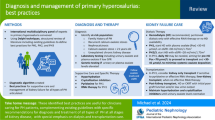Abstract
The porphyrias are inherited or acquired metabolic disorders caused by a partial deficiency in one of the enzymes of the heme biosynthetic pathway. Eight enzymes are utilized in the synthesis of heme. An enzyme defect in one of the last seven enzymes will result in one of the seven different forms of porphyria, some of which have similar signs and symptoms.
This article describes six diabetic, azotemic patients with no prior history of porphyria, who developed a syndrome similar to acute intermittent porphyria after initiation of treatment with erythropoietin. One of the patients developed the syndrome predialysis, whereas the remaining patients were on maintenance hemodialysis. The symptoms varied but all resolved when erythropoietin was discontinued and reappeared in four cases when erythropoietin was restarted. In all of the patients, the enzyme aminolevulinic acid-dehydratase (ALA-D) was low and the uroporphyrinogen synthase was normal. This enzyme abnormality suggests an acquired form of δ-aminolevulinic acid dehydratase porphyria (ADP). Lead toxicity, succinylacetone, and zinc deficiency are known to depress ALA-D, but these conditions were not present.
The development of the acute porphyria syndrome while the patients were receiving pharmacological doses of erythropoietin, which resolved when the drug was stopped, suggests that by stimulating heme synthesis, erythropoietin may unmask an enzyme deficiency resulting in the clinical expression of ADP.
The patients responded favorably to a regimen that included discontinuation of erythropoietin, tight blood sugar control, maintaining the hematocrit above 30%, and a KT/V, a measure of dialysis adequacy, of 1.5 in the hemodialysis group. Plasmapheresis accelerated the recovery when used in two patients.
Similar content being viewed by others
References
Wehrmacher WH. New symptomatic treatment for acute intermittent porphyria. AMA Arch Int Med 1952;89:111–114.
Williams WJ, Beutler E, Erslev AS, Lechtman MA. The porphyrias In: The Metabolic And Molecular Bases of Inherited Disease 7th ed (Scriver CR, et al., eds.) McGraw-Hill, New York, NY, 1990, pp. 2103–2142.
Day RS, Eales L, Disler PB. Porphyrias and the kidney. Nephron 1981;28:261–267.
Williams WJ, Beutler E, Erslev AS, Lechtman MA. The porphyrias. In: Hematology 4th ed. McGraw-Hill, New York, NY, 1990.
Saks, GH. Acute intermittent porphyria. JAMA 1990;264:1290–1293.
Doss M, Schneider J, Von Tiepermann R, Brandt A. New type of acute porphyria with porphobilinogen synthase (δ-aminolevulinic acid dehydratase) defect in the homozygous state. Clin Biochem 1982;15(1):52–55.
Ford RE, Ou CN, Ellefson RD. Assay for erythrocyte uroporphyrinogen 1 synthase activity, with porphobilinogen as substrate. Clin Chem 1980;26(8):1182–1185.
Teferi A, Colgan JP, Solberg A. Acute porphyrias: diagnosis and management. Mayo Clin Proc 1994;69:991–995.
Chaudhry, MR, Meningism, pericarditis/myocarditis—unrecognised manifestations of acute porphyria. J Pak Med Assoc 1986;36:239–243.
Porphyric Neuropathy. Disease of the Peripheral Nervous System, Chap 60.
Goldsman CI, Taylor JS. Porphyria cutanea tarda and bullous dermatoses associated with chronic renal failure: a review. Cleve Clin Q 1983;50:151–161.
Ishida N, Fujita H, Fukuda Y, et al. Cloning and expression of the defective genes from a patient with δ-aminolevulinate dehydratase porphyria. J Clin Invest 1992;89:1431–1437.
Doss M, von Tiepermann R, Schneider J, Schmid H. New type of hepatic porphyria with porphobilinogen synthase defect and intermittent acute clinical manifestation. Klin Wochenschr 1979;57:1123–1127.
Nandi DL. Inhibition of delta aminolevulinic acid dehydratase of rhodopseudomonas spheroides by urea, guanidine and methyl derivatives of urea. Arch Biochem Biophys 1971;142:157–162.
Djordjevic, VB: δ-Aminolevulinic acid dehydratase activity is erthrocytes of diabetic patients. Arch Int Physiol Biochim 1985;93:285–290.
Djorgjevic VB, Strahinjic S, Koracevic D, et al. Erythrocyte δ-aminolevulinate dehydratase measurement inBalkan endemic nephropathy. Kidney Int 1991;40(34):S-93–S-96.
Ishida N, Fujita H, Noguchi T, Doss M, Kappas A, Sassa S. Message amplification phenotyping of an inherited δ-aminolevulinate dehydratase deficiency in a family with acute hepatic porphyria. Biochem Biophys Res Commun 1990;172(1):237–242.
Fujita H, Sassa S, Ludgren J, Holmberg L, Thunell S, Kappas A Enzymatic defect in a child with hereditary hepatic porphyria due to homozygous δ-aminolevulinic acid dehydratase deficiency: immunochemical studies. Pediatrics 1987;80(6):880–885.
Moore MR, Beattie AD, Thompson GG. Depression of delta aminolevulinic acid dehydratase activity by ethanol in man and rat. Clin Sci 1971;40:81–88.
Plewinska M, Thunell S, Holmberg L, Wermur JG, Desnick RJ. δ-Aminolevulinate dehydratase deficient porphyria; identification of the molecular lesion in a severely affected homozygote. Am J Hum Genet 1991;49:167–174.
Djorgjevic VB, Strahinjic S, Koracevic D, et al. Erythrocyte δ-aminolevulinate dehydratase measurement in Balkan endemic nephropathy. Kidney Int 1991;40(34):S-93–S-96.
Fontanellas A, Herrero JA, Coronel F, et al. Effects of recombinant human erythropoietin on porphyrin metabolism in uremic patients on hemodialysis. J Am Soc Nephrol 1996;7:774–779.
Kraupp M, Linkesch W, Watzinger U, Legenstein E, Graf H. Enzymes of heme biosynthesis in erythrocytes of patients treated with recombinant erythropoietin. Blut 1989;59:340.
Ibrahim N, Gruenspecht NR, Freedman ML. Hemin feedback inhibition at reticulocyte δ-aminolevulinic acid synthetase and δ-aminolevulinic acid dehydratase. Biochem Biophys Res Commun 1978;80(4):722–728.
Robert TL, Varella L, Meguid MM. Nutrition management of acute intermittent porphyria. Nutrition 1994;10(6):551–556.
Author information
Authors and Affiliations
Corresponding author
Additional information
The authors have stated that they do not have a significant financial interest or other relationship with any product manufacturer or provider of services discussed in this article. The authors do not discuss the use of off-label products, which includes unlabeled, unapproved, or investigative products or devices.
About this article
Cite this article
Hedger, R.W., Wehrmacher, W.H. & French, A.V. Porphyria syndrome associated with diabetic nephrosclerosis and erythropoietin. Compr Ther 32, 163–171 (2006). https://doi.org/10.1007/s12019-006-0007-4
Received:
Accepted:
Published:
Issue Date:
DOI: https://doi.org/10.1007/s12019-006-0007-4




